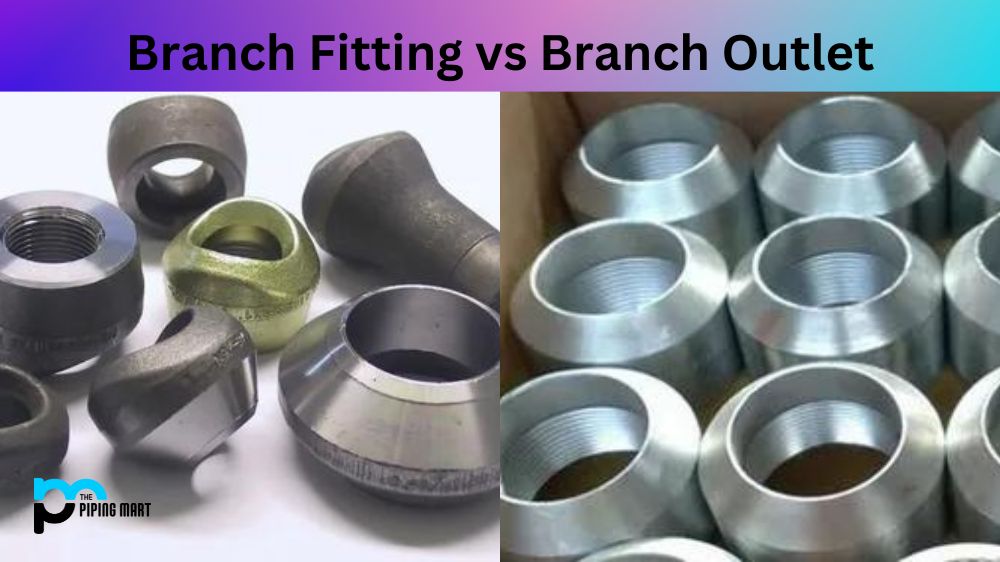Branch fittings and branch outlets are two common components used in piping systems. While they may appear similar, they have distinctive differences. If you’re into piping systems, knowing the difference between these two components is important to make informed decisions when choosing the right part for your application. This blog post will compare and contrast branch fittings vs branch outlets and identify their functions and applications.
What is Branch Fitting?
Branch Fitting is the process of connecting pipes and fittings of different sizes. It’s a specialized type of plumbing which involves cutting, preparing, and attaching pipe to other components such as elbows, tees, reducers, etc. This ensures water and other liquid substances flow throughout a system. They are commonly used in commercial or residential applications such as potable water supply systems, drainage systems, irrigation networks or industrial manufacturing processes. Proper knowledge of safe installation techniques is essential for efficient results with long service life from the branch fitting materials used. Keywords: Pipe Fitting; Connecting Pipes; Elbows; Tees; Reducers; Plumbing Installation; Commercial Applications
What is Branch Outlet?
A branch outlet is a fitting type commonly used in piping systems. The main purpose of a branch outlet is to connect a larger main pipe to a smaller secondary pipe at a perpendicular angle. This allows for the distribution of fluids and gases in multiple directions. These fittings come in various sizes and materials, depending on the specific application’s requirements. A properly installed branch outlet can improve a piping system’s overall efficiency and longevity.
Difference Between Branch Fitting and Branch Outlet
Definition and Characteristics
Simply put, a branch fitting is a component designed to join multiple pipes with a common run or branch, while a branch outlet is a component designed to create a branch from a main pipe. A branch fitting allows the formation of a single pipe network from multiple pipes, while a branch outlet permits two separate pipelines to continue their flow. Branch fittings are commonly used in pipelines 2 inches or fewer, while branch outlets are used in pipes above 2 inches. Both components are designed with specific characteristics that suit their respective functions.
Types of Branch Fittings and Branch Outlets
Branch fittings come in different types, including elbow, tee, cross, wye, and lateral. Elbows allow for a 90-degree change in direction, while a tee is used for a three-way connection. A cross is used for a four-way connection, and a wye allows for a branch from the main pipeline at an angle. Lateral allows for a branch perpendicularly from the main pipe, commonly used in underground piping systems. On the other hand, branch outlets come in different types, such as threaded, welded, and socket-welded, and each type suits a particular use.
Applications
Branch fittings and branch outlets are used in different applications. Branch fittings, with their different types, can be used in plumbing, gas, oil refineries, power plants, and chemical and petrochemical plants. Elbows, tees, crosses, and Y- and fittings are widely used in plumbing systems, while lateral fittings are mainly used in outdoor scenes and underground piping systems. In contrast, branch outlets are used in pipelines where a branch is required from a main pipe, for instance, in hot water systems that feed different building parts.
Design and Construction
Branch fittings and branch outlets have different designs and construction. Branch fittings are made of brass, steel, plastics, and other materials that suit their intended application. They are designed to withstand high-pressure and high-temperature loads. On the other hand, branch outlets are made of stainless steel, carbon steel, nickel alloy, and chrome-moly. They are designed with three chambers: the flow chamber, the mounting chamber and the seal chamber, which helps ensure proper flow and sealing.
Connection Process
Branch fittings and branch outlets have different connection processes. Branch fittings need to be welded or joined at the connecting junction to form a network of pipes. The number of welding or joining depends on the type of fitting. Branch outlets, however, are mostly welded or threaded onto the main pipe. Welding guarantees stronger and leak-proof connections, while threaded branch outlets are easier to install and remove.
Conclusion:
In summary, branch fittings and outlets are essential components in piping systems. While the two may seem similar, they are designed and constructed differently and serve different functions and applications. Understanding the differences between these components is key to making informed decisions regarding the choice of component for your piping system. We hope this blog post has provided significant insights into the distinctive characteristics of branch fittings and outlets.

Hey, I’m Krutik, a casual blogger expert in the metal industry. I am passionate about providing valuable information to my readers. With a background in engineering and construction, I like playing Cricket & watching Netflix shows in my free time. Thank you for visiting my blog, and I hope you find my information helpful!




